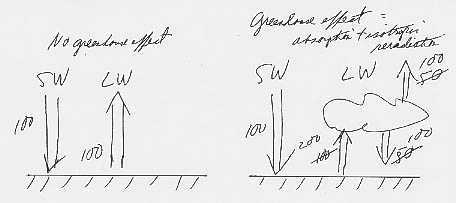
HPR109F, Spring 2001
Answers to midterm exam, Thursday 22 March 2001
Chapters 1–6
Definitions (2 points each; 20
points total)
1. Negative feedback loop—a feedback
loop that tends to diminish the effect of disturbances; contains an odd number
of couplings.
2. Albedo—the fraction of incoming
radiation reflected by a surface.
3. Latent heat—heat energy released
or absorbed during the transition from one phase to another. Used here for
transitions of water.
4. Stratosphere—the stable layer of
atmosphere directly above the troposphere.
5. Stable equilibrium—a state of a
system to which it returns after being disturbed.
6. Coriolis effect—The tendency for moving air or water to be
deflected from its apparent straight-line path rightward in the northern
hemisphere and leftward in the southern hemisphere.
7. Thermohaline circulation—the
circulation of the deep oceans, which is driven by differences in density that
result from differences in temperature and salinity.
8. Ekman spiral—a systematic curling
of the direction of oceanic flow with depth. Caused by surface winds, friction,
and the Coriolis effect.
9. Moho—boundary between crust and
mantle. Speed of seismic waves increases rapidly there.
10. Wilson cycle—the regular breakup
and reassembly of supercontinents. Its period is 500 years.
Short answers (3 points each; 30
points total)
1. What did Keeling learn about
atmospheric CO2 from his measurements at Mauna Loa, Hawaii? That
over and above its annual cycle of 5–6 ppm, it is increasing monotonically
with time.
2. Contrast the degree to which CO2
correlates with average temperature on time scales of decades versus tens of
thousands of years. It does not correlate particularly well with temperature
on the decadal scale. On the ice-age scale it correlates much better.
3. What is currently the most important
greenhouse gas on earth? Water vapor.
4. What has been the typical climate of
Rhode Island for the last two million years? Under two thousand feet of
ice.
5. Given the basic stability of the
earth’s climatic system, would you most expect to find positive or negative
feedback loops in it, and why? Negative
loops, because they tend to preserve the state of the system ( to stabilize it).
6. How and where is bottom water formed? It
is formed near Greenland in Iceland in the north and in the Weddell Sea in the
south. The water is made so dense by cooling and by salt ejected from the sea
ice that is forming at the surface.
7. Where do the temperatures vary more
with season, over continents or oceans, and why? Temperatures vary more with
season over the continents because they have a lower heat capacity than the
oceans. Part of the reason is the smaller heat capacity is due to the properties
of rock, and part is because the continents cannot carry the heat downward as
easily as the oceans can.
8. Explain briefly how geostrophic flow
reinforces the flow in the North Atlantic gyre that is created by surface winds.
Use a diagram if it will help. The clockwise surface winds and the associated
Ekman transport at depth direct water toward the center of the North Atlantic
gyre, where it piles up. The surface of this water then runs off toward the
sides, during which the Coriolis force deflects it to the right and in
conjunction with the pressure force creates clockwise flow that reinforces the
clockwise flow from the winds.
9. List and briefly explain the various
possible sources of heat for the earth’s core. (1) Radioactive decay. (2)
Residual heat from collisions with asteroids, etc., as the earth was being
formed. (3) Gravitational energy released as the heavier matter sinks to form
the core.
10. What is the polar front, and how do
storms form along it? The polar front is the place where warm, moist air from
the tropics meets cool, dry air from higher latitudes. Storms form as a
disturbance destabilizes the two columns of air and the denser cold one moves
under the lighter warm one. This lowers the center of gravity of the system and
turns potential energy into kinetic energy (the energy of the storm).
Problems and longer answers (10
points each; 50 points total)
1. Assume 100 flux units of solar radiation being absorbed at the
earth’s surface. Use a simple diagram to show the fundamental mechanism of the
greenhouse effect and how it doubles the radiation leaving the surface.

2. Given the cross-sectional solar energy flux to earth S = 1370 W m-2, the earth’s albedo of 30%, and the Stefan-Boltzmann constant of s = 5.67 x 10-8 W m-2 K-4, derive the formula for the equilibrium temperature of the earth’s surface in the absence of a greenhouse effect, and calculate that temperature in Kelvin units.
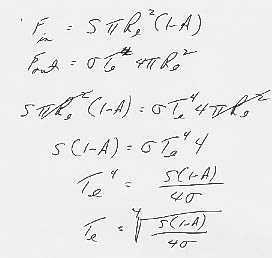
3. Use diagrams to derive the earth’s three-celled atmospheric circulation. Be sure to show why one cell and two cells don’t work. (1) The one-celled circulation produces friction that would slow down the earth, which cannot be. (2) The two-celled circulation can balance out the frictional effects, but creates rising air at the pole or sinking air at the equator, both of which are impossible. (3) The three-celled circulation balances the friction and allows the air to rise at the equator and sink at the poles.
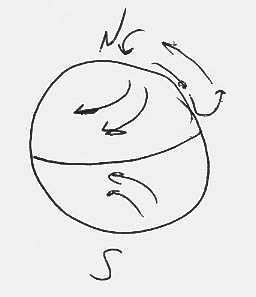
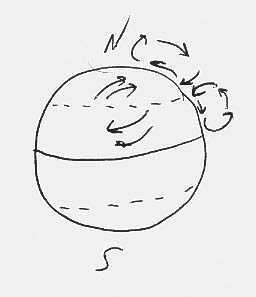
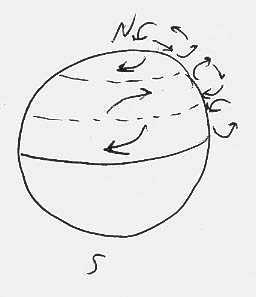
4. Use the three components of relative vorticity and their changes with
location to explain the asymmetry of the North Atlantic gyre. You may use a
diagram to help. (See Box Figure 5-1 in the book.) On the west side of the
gyre (near Florida), the positive vorticity from friction with the continent
must offset the decrease in vorticity from moving north and the decrease in
vorticity as the water begins to rotate clockwise. The was to increase the
frictional component is to speed up the water, narrow its path so that more of
it interacts frictionally with the continent, and deepen it for the same reason.
On the eastern side of the gyre (Europe and Africa) the positive vorticity from
friction need only balance out the difference between the increasing vorticity
from moving south and the decreasing vorticity from turning clockwise at the
edge of the continent. Thus the friction has to do a lot less, and so the
resulting current can be slow, wide and shallow.
5. List and describe the chain of influences inside the earth that lead
to plate tectonics (drifting continents). Start from the core, progress up
through the mantle, and pass through the asthenosphere to the continental and
oceanic crust. Use a diagram if it will help. (1) The hot core heats the
bottom of the overlying mantle and destabilizes it, just as heat at the
earth’s surfaces destabilizes the lower part of the troposphere. (2) In
response to the heat, rock in the mantle convects slowly in closed
“vertical” cells. (3) The top of these convection cells pulls plates
horizontally. (4) The plates float on the top of the asthenosphere.